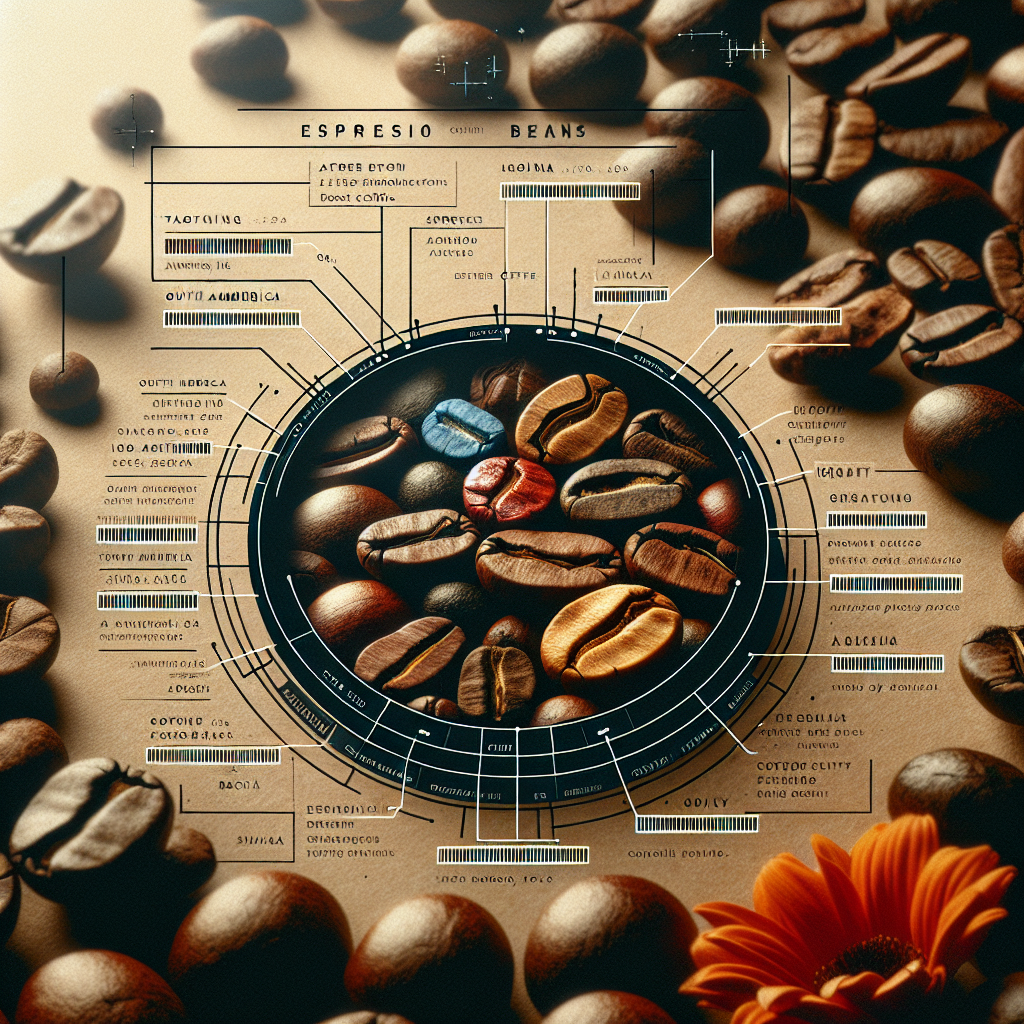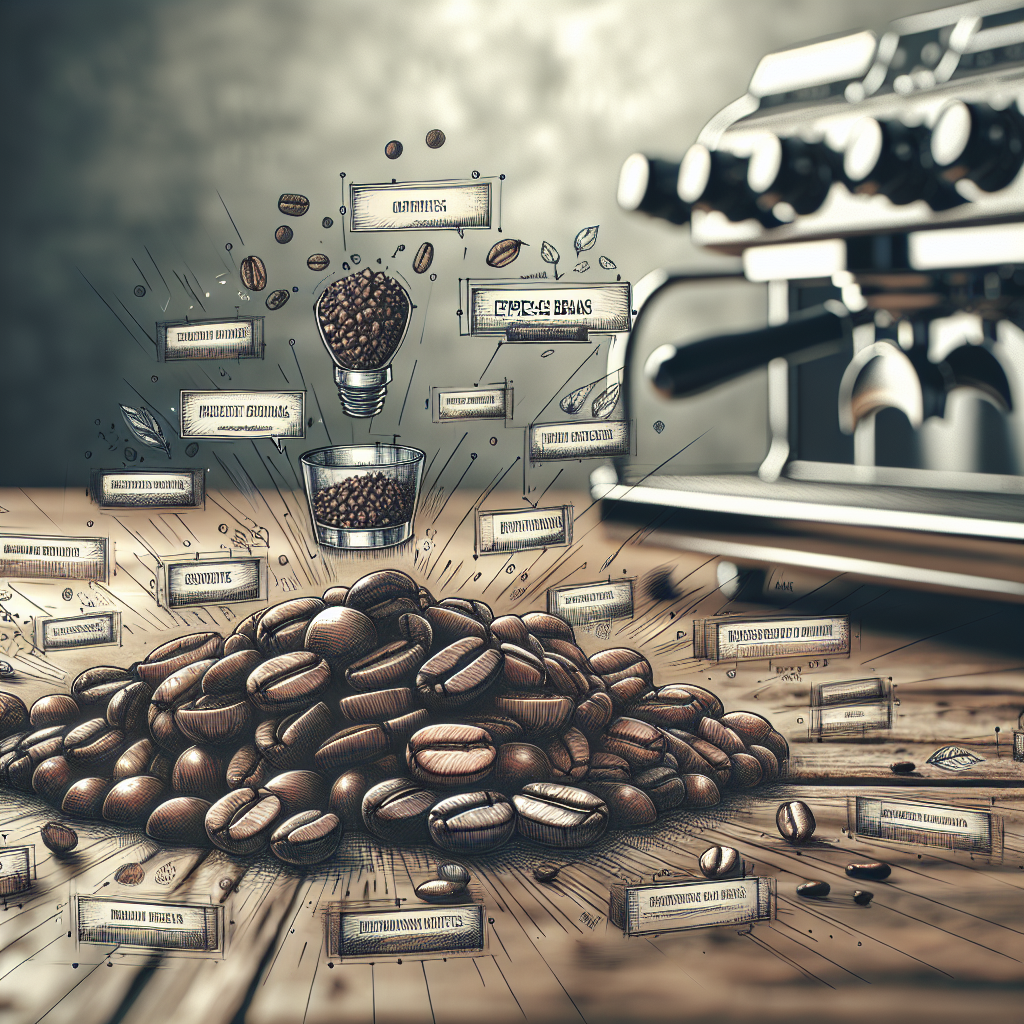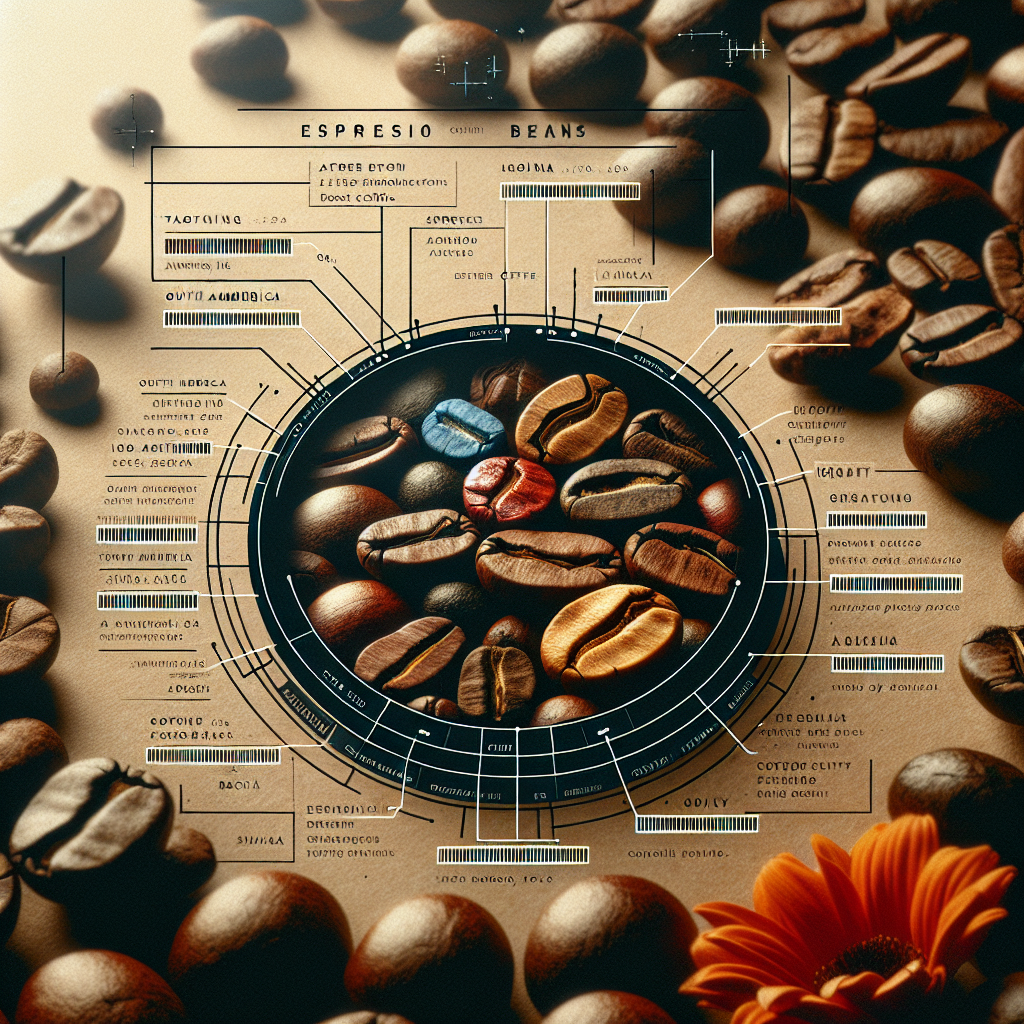Are you a coffee lover searching for the perfect espresso beans to elevate your daily cup of joe? Look no further! In “The Ultimate Guide to Choosing the Best Espresso Beans,” we will take you on a delightful journey through the world of espresso beans, providing you with valuable insights and tips on how to select the beans that best suit your taste buds. Whether you prefer a rich and bold flavor or a smooth and subtle taste, this comprehensive guide has got you covered. So grab your favorite mug and get ready to discover the secrets to brewing the perfect espresso every time.

Roast Level
When it comes to espresso beans, one of the first decisions you’ll need to make is the roast level. The roast level refers to how long the beans have been roasted, and it greatly impacts the flavor and aroma of your espresso. There are three main roast levels to choose from: light roast, medium roast, and dark roast.
Light Roast
Light roast espresso beans are roasted for the shortest amount of time, typically until just after the first crack. This roast level produces beans that are light brown in color and have a crisp, bright flavor profile. Light roast beans tend to have higher acidity and a lighter body, making them perfect for those who enjoy a more delicate and vibrant espresso experience. If you’re a fan of fruity and floral notes in your espresso, light roast beans are a great choice.
Medium Roast
Medium roast espresso beans are roasted for a slightly longer time, giving them a medium brown color and a balanced flavor profile. These beans have a good balance between acidity and sweetness, with a smooth and well-rounded taste. Medium roast beans are a popular choice for espresso lovers as they offer a versatile and approachable cup of coffee. Whether you enjoy your espresso black or with milk, medium roast beans can deliver a satisfying and well-balanced flavor.
Dark Roast
Dark roast espresso beans are roasted for the longest time, resulting in beans that are dark brown or even black in color. This roast level produces beans with a bold and intense flavor profile, characterized by low acidity and a heavy body. Dark roast beans often have smoky or chocolatey undertones, making them a popular choice for those who prefer a rich and robust espresso. If you enjoy a strong and full-bodied espresso with a bittersweet taste, dark roast beans are the way to go.
Bean Origin
Another important factor to consider when choosing espresso beans is their origin. The origin of the beans refers to the country or region where they were grown. Different regions around the world produce coffee with unique flavors and characteristics, allowing you to explore a diverse range of taste profiles in your espresso.
Single Origin Beans
Single origin espresso beans come from a specific geographical location, such as a particular farm or region within a country. These beans offer a distinct flavor profile that reflects the unique terroir and climate of their origin. Single origin beans are often praised for their complexity and individuality, allowing you to taste the unique characteristics of a specific growing region. If you’re looking for an espresso with a pronounced and nuanced flavor, single origin beans are a great choice.
Blended Beans
Blended espresso beans are a mix of beans from different regions or farms. Coffee roasters carefully select and combine beans with complementary flavors, resulting in a well-balanced and harmonious cup of espresso. Blends are often created to achieve consistency in taste, ensuring that every cup of espresso from the same blend tastes similar. If you prefer a more balanced and consistent flavor in your espresso, blended beans are a reliable choice.
Bean Variety
The type of coffee bean used in your espresso can greatly impact its flavor and characteristics. There are two main varieties of coffee beans: Arabica beans and Robusta beans.
Arabica Beans
Arabica beans are often considered the superior choice for espresso due to their high-quality flavor profiles. These beans are known for their delicate and complex flavors, which can range from fruity and floral to nutty and chocolatey. Arabica beans have a lower caffeine content compared to Robusta beans, making them ideal for those who prefer a milder espresso experience. If you enjoy a nuanced and flavorful espresso, Arabica beans are a great option.
Robusta Beans
Robusta beans are known for their strong and bold flavors, making them a popular choice for espresso blends. These beans have a higher caffeine content and a more robust and intense flavor compared to Arabica beans. Robusta beans are often characterized by their earthy and bitter taste, which can be balanced by blending them with Arabica beans. If you prefer a strong and full-bodied espresso with a higher caffeine kick, Robusta beans are worth considering.
Blend of Arabica and Robusta Beans
Many espresso blends combine both Arabica and Robusta beans to achieve a balance between flavor and caffeine content. By blending the two varieties, coffee roasters can create a unique and well-rounded espresso that showcases the best qualities of each bean. The Arabica beans contribute complexity and flavor, while the Robusta beans add body and strength. If you’re looking for a versatile espresso that combines the best of both worlds, a blend of Arabica and Robusta beans is a great choice.
Freshness
Freshness is key when it comes to brewing the best espresso. To ensure that your espresso beans deliver a rich and flavorful cup of coffee, it’s important to pay attention to the freshness indicators provided on the packaging.
Roasted-on Date
The roasted-on date is an important indicator of the freshness of your espresso beans. It tells you when the beans were roasted, allowing you to gauge how long they have been sitting on the shelf. Ideally, you should look for beans that have been roasted recently, as they will have the highest level of freshness and flavor. As a general guideline, try to consume your espresso beans within two to four weeks of the roasted-on date for the best taste.
Expiry Date
While not as crucial as the roasted-on date, the expiry date provides a useful reference point for the freshness of your espresso beans. It indicates the date after which the beans may start to lose their flavor and quality. While it’s still safe to consume beans past the expiry date, they may not deliver the same robust and nuanced flavors as fresher beans. Aim to finish your espresso beans before the expiry date to enjoy them at their best.
Storage
Proper storage is essential for maintaining the freshness of your espresso beans. To prolong their shelf life and preserve their flavors, it’s important to store your beans in a cool and dry place, away from direct sunlight, moisture, and strong odors. It’s best to store them in an airtight container or bag, away from heat sources such as the stove or the refrigerator. Avoid grinding your beans until just before brewing to retain their freshness for as long as possible.

Grind Size
The grind size of your espresso beans is crucial for achieving the perfect extraction and flavor in your espresso. Different brew methods require different grind sizes, and espresso is known for requiring a fine and consistent grind.
Coarse Grind
Coarse grind is typically used for brewing methods like French press or cold brew, but it is not suitable for making espresso. Coarse grind beans have a larger particle size, which results in a slower extraction and a weaker flavor when used for espresso. If you’re aiming for a bold and concentrated shot of espresso, it’s best to avoid using coarse grind beans.
Medium Grind
Medium grind is a versatile option that works well for various brewing methods, including espresso. This grind size allows for a balanced extraction and a flavorful cup of coffee. Medium grind beans have a consistent size and texture, making them ideal for use in espresso machines. If you’re using an espresso machine at home, medium grind beans are a reliable choice.
Fine Grind
Fine grind is the most suitable grind size for making espresso. This grind allows for a quick and efficient extraction, producing a strong and concentrated shot of espresso. Fine grind beans have a smaller particle size, which allows for a higher surface area and optimal flavor extraction. If you’re looking to achieve the perfect espresso shot with a rich and full-bodied flavor, fine grind beans are a must-have.
Flavor Profile
The flavor profile of your espresso is determined by various factors, including the roast level, bean origin, and brewing method. Understanding the different elements that contribute to the flavor profile can help you choose beans that align with your taste preferences.
Acidity
Acidity is an important component of espresso flavor. It refers to the brightness or liveliness of the coffee and can range from mild to high. Some espresso lovers enjoy a crisp and tart acidity, while others prefer a smoother and more mellow cup. Light roast beans and certain single origin beans tend to have higher acidity, while darker roasts and blends may have lower acidity. Experimenting with different beans can help you discover your preferred level of acidity.
Bitterness
Bitterness is another element that plays a significant role in espresso flavor. It adds depth and complexity to the taste profile, but excessive bitterness can be unpleasant. Dark roast beans and Robusta beans often have a more pronounced bitterness, while lighter roasts and Arabica beans tend to be milder in this aspect. Balancing the bitterness with other flavors like sweetness and acidity is key to achieving a well-rounded and enjoyable cup of espresso.
Sweetness
Sweetness in espresso can range from subtle hints of caramel or chocolate to a more pronounced sugary taste. Sweetness can come from the natural sugars present in the beans or the caramelization that occurs during the roasting process. Light roast beans and certain single origin beans are known for their delicate sweetness, while darker roasts and blends may offer a deeper and more caramel-like sweetness. The level of sweetness you prefer in your espresso is a matter of personal taste.
Body
Body refers to the texture and mouthfeel of the espresso. It can range from light and tea-like to full and syrupy. A coffee with a heavier body will feel more substantial and linger longer on the palate. Dark roast beans and Robusta beans often offer a fuller body, while lighter roasts and Arabica beans may have a lighter and smoother mouthfeel. Consider the body of the espresso when choosing your beans to ensure it aligns with your desired taste experience.
Aroma
Aroma plays a crucial role in the overall enjoyment of your espresso. It can greatly enhance the tasting experience and provide a sensory delight. The aroma of espresso beans can be influenced by factors such as roast level, bean origin, and the brewing method used. Light roast beans and certain single origin beans often have a more floral and nuanced aroma, while darker roasts and blends may have a stronger and more pronounced scent. Pay attention to the aroma when selecting your beans to ensure it complements your taste preferences.
Caffeine Content
The caffeine content of your espresso can vary depending on the type of beans used. Choosing beans with the right caffeine content can help you achieve the desired energy boost without going overboard.
High Caffeine Content
If you’re looking for an extra kick of energy, consider espresso beans with a high caffeine content. Robusta beans are known to have a higher caffeine content compared to Arabica beans, making them a popular choice for those seeking a strong and potent espresso. Be aware that high caffeine content can result in a more powerful and intense flavor profile, so it’s important to find the right balance that suits your taste preferences.
Moderate Caffeine Content
Arabica beans are generally known to have a moderate caffeine content compared to Robusta beans. This makes them a popular choice for those who enjoy espresso but prefer a milder and more balanced caffeine experience. Moderate caffeine content in your espresso can provide a gentle energy boost without overwhelming your senses. If you’re looking for a well-rounded and smooth espresso experience, beans with a moderate caffeine content are a good choice.
Low Caffeine Content
If you’re sensitive to caffeine or prefer to limit your overall consumption, choosing espresso beans with a low caffeine content can be beneficial. Light roast beans, especially those made from Arabica beans, often have a lower caffeine content compared to darker roasts and Robusta beans. Opting for beans with a lower caffeine content allows you to enjoy the flavors and aromas of espresso without the strong stimulant effects. It’s important to note that the brewing method can also affect the caffeine content, so consider that when making your selection.
Packaging Type
The packaging type of your espresso beans can affect the freshness and longevity of their flavor. Choosing the right packaging ensures that your beans stay in optimal condition until you’re ready to brew.
Whole Bean
Whole bean coffee is generally considered the best option for maintaining freshness. When espresso beans are left whole, they retain their flavors and aromas for longer periods. This is because the protective outer layer of the beans remains intact, preventing oxidation and flavor loss. Whole bean espresso also allows for more control over the grind size, resulting in a more precise and flavorful extraction. If you have a grinder at home or prefer a fresher cup of espresso, whole bean packaging is ideal.
Ground Coffee
Ground coffee is a convenient option for those who want to skip the grinding process and brew their espresso quickly. However, it’s important to note that ground coffee loses its freshness more quickly than whole beans. Once the beans are ground, more surface area is exposed to air, causing the flavors to dissipate faster. If you choose to buy pre-ground espresso, consider smaller package sizes to ensure you can consume the coffee before it loses its freshness. While convenient, ground coffee may not deliver the same vibrant and robust flavors as freshly ground beans.
Budget
Your budget is an important consideration when it comes to buying espresso beans. Luckily, there are options available for every price range, allowing you to enjoy a delicious cup of espresso without breaking the bank.
Premium Beans
Premium espresso beans are often sourced from specialty coffee farms and offer exceptional quality and flavor. These beans are typically single origin or carefully curated blends, showcasing the best of what the coffee world has to offer. Premium beans may come at a higher price point, but the investment allows you to indulge in a consistently excellent cup of espresso. If you’re looking for a luxurious and top-notch espresso experience, premium beans are worth considering.
Budget-Friendly Beans
If you’re on a tight budget or simply looking for a more affordable option, there are plenty of budget-friendly espresso beans available. These beans may not have the same level of complexity and refinement as premium beans but can still deliver a satisfying and flavorful cup of espresso. Budget-friendly beans often come in blended or medium roast options, offering versatility and affordability. Don’t be afraid to explore different brands and blends to find a budget-friendly option that suits your taste preferences.
Personal Preference
At the end of the day, your personal preference plays a significant role in choosing the best espresso beans for you. With so many options available, it’s important to experiment and discover what flavors and characteristics you enjoy the most.
Experimenting with Different Beans
One of the joys of being an espresso lover is the opportunity to experiment with different beans and flavor profiles. Don’t be afraid to step out of your comfort zone and try beans from various origins, blends, and roast levels. By exploring different options, you can expand your palate and discover new and exciting flavors in your espresso. Keep a record of your favorite beans and take note of the characteristics you enjoy, allowing you to refine your preferences over time.
Taste Testing
Taste testing is an excellent way to compare different espresso beans and determine which ones you prefer. When conducting a taste test, it’s best to brew your espresso using the same parameters, such as grind size, water temperature, and brew time. This ensures a fair comparison and allows you to focus solely on the flavor profiles of the beans. Take the time to savor each cup and pay attention to the nuances in taste, acidity, body, and aroma. By conducting taste tests, you can identify the beans that align most closely with your taste preferences and make informed decisions when purchasing espresso beans.
In conclusion, choosing the best espresso beans is a highly personal and subjective process. From considering the roast level and bean origin to exploring different flavor profiles and caffeine content, there are numerous factors to take into account. Remember to experiment, taste test, and trust your palate to find the beans that deliver the perfect cup of espresso for you. Whether you prefer a light roast single origin with vibrant acidity or a dark roast blend with a rich body, the world of espresso beans offers endless possibilities for coffee enthusiasts like yourself. Happy brewing!

